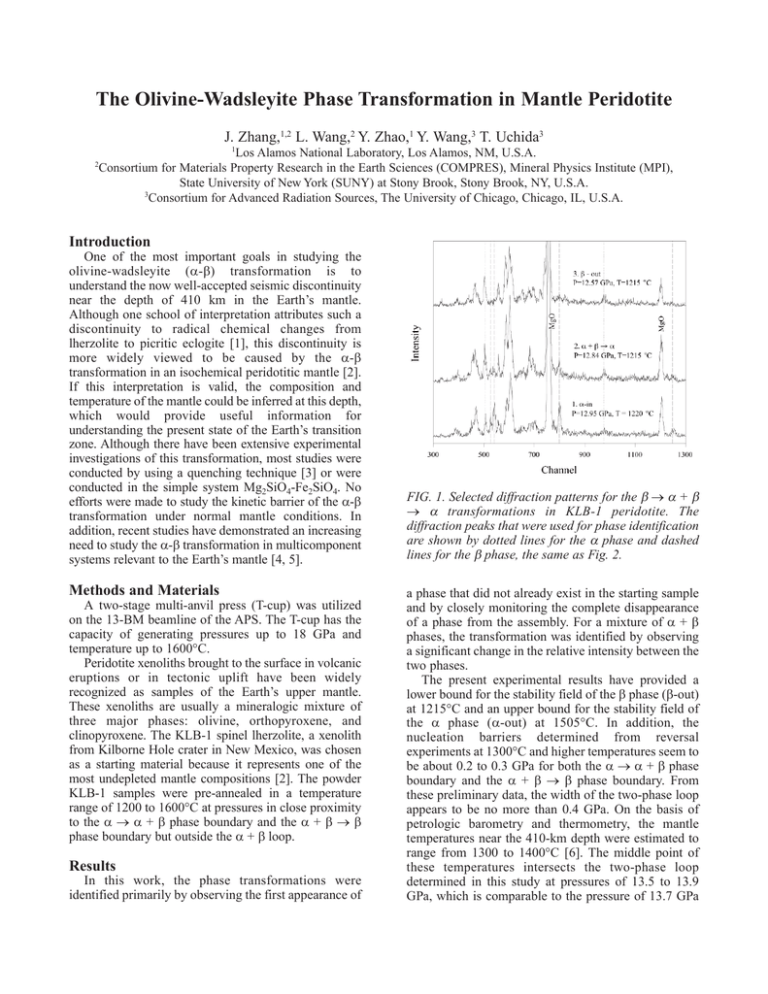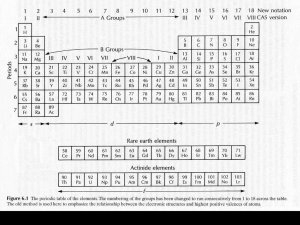The Olivine-Wadsleyite Phase Transformation in Mantle Peridotite J. Zhang, L. Wang, Y. Zhao,
advertisement

The Olivine-Wadsleyite Phase Transformation in Mantle Peridotite J. Zhang,1,2 L. Wang,2 Y. Zhao,1 Y. Wang,3 T. Uchida3 1 Los Alamos National Laboratory, Los Alamos, NM, U.S.A. Consortium for Materials Property Research in the Earth Sciences (COMPRES), Mineral Physics Institute (MPI), State University of New York (SUNY) at Stony Brook, Stony Brook, NY, U.S.A. 3 Consortium for Advanced Radiation Sources, The University of Chicago, Chicago, IL, U.S.A. 2 Introduction One of the most important goals in studying the olivine-wadsleyite (α-β) transformation is to understand the now well-accepted seismic discontinuity near the depth of 410 km in the Earth’s mantle. Although one school of interpretation attributes such a discontinuity to radical chemical changes from lherzolite to picritic eclogite [1], this discontinuity is more widely viewed to be caused by the α-β transformation in an isochemical peridotitic mantle [2]. If this interpretation is valid, the composition and temperature of the mantle could be inferred at this depth, which would provide useful information for understanding the present state of the Earth’s transition zone. Although there have been extensive experimental investigations of this transformation, most studies were conducted by using a quenching technique [3] or were conducted in the simple system Mg2SiO4-Fe2SiO4. No efforts were made to study the kinetic barrier of the α-β transformation under normal mantle conditions. In addition, recent studies have demonstrated an increasing need to study the α-β transformation in multicomponent systems relevant to the Earth’s mantle [4, 5]. Methods and Materials A two-stage multi-anvil press (T-cup) was utilized on the 13-BM beamline of the APS. The T-cup has the capacity of generating pressures up to 18 GPa and temperature up to 1600°C. Peridotite xenoliths brought to the surface in volcanic eruptions or in tectonic uplift have been widely recognized as samples of the Earth’s upper mantle. These xenoliths are usually a mineralogic mixture of three major phases: olivine, orthopyroxene, and clinopyroxene. The KLB-1 spinel lherzolite, a xenolith from Kilborne Hole crater in New Mexico, was chosen as a starting material because it represents one of the most undepleted mantle compositions [2]. The powder KLB-1 samples were pre-annealed in a temperature range of 1200 to 1600°C at pressures in close proximity to the α → α + β phase boundary and the α + β → β phase boundary but outside the α + β loop. Results In this work, the phase transformations were identified primarily by observing the first appearance of FIG. 1. Selected diffraction patterns for the β → α + β → α transformations in KLB-1 peridotite. The diffraction peaks that were used for phase identification are shown by dotted lines for the α phase and dashed lines for the β phase, the same as Fig. 2. a phase that did not already exist in the starting sample and by closely monitoring the complete disappearance of a phase from the assembly. For a mixture of α + β phases, the transformation was identified by observing a significant change in the relative intensity between the two phases. The present experimental results have provided a lower bound for the stability field of the β phase (β-out) at 1215°C and an upper bound for the stability field of the α phase (α-out) at 1505°C. In addition, the nucleation barriers determined from reversal experiments at 1300°C and higher temperatures seem to be about 0.2 to 0.3 GPa for both the α → α + β phase boundary and the α + β → β phase boundary. From these preliminary data, the width of the two-phase loop appears to be no more than 0.4 GPa. On the basis of petrologic barometry and thermometry, the mantle temperatures near the 410-km depth were estimated to range from 1300 to 1400°C [6]. The middle point of these temperatures intersects the two-phase loop determined in this study at pressures of 13.5 to 13.9 GPa, which is comparable to the pressure of 13.7 GPa at the 410-km seismic discontinuity. This match elicits additional confidence in the experimental results that have been obtained. FIG. 2. Selected diffraction patterns for the α → α + β → β transformations. Discussion A phase diagram constructed on the basis of experimental results is shown in Fig. 3. The two solid lines are the equilibrium phase boundaries for the α → α + β transformation and the α + β → β transformation, each of which is bracketed by two kinetic boundaries (dashed lines for the α → α + β boundary, and dotted lines for the α + β → β boundary). The large open triangle indicates the result obtained from a different experiment conducted at the National Synchrotron Light Source (NSLS) at Brookhaven National Laboratory. Three considerations were taken into account to construct this diagram, given the limited experimental constraints. The first one was the fact that the nucleation barrier at high temperatures must be no larger than it is at lower temperatures. The other two are assumptions. First, at temperatures above 1200°C [1], the nucleation barriers are symmetric for forward and back transformation. Second, the nucleation barrier for the α → α + β boundary is comparable to that for the α + β → β boundary. The first assumption seems to be justified by inspecting the coesite-stishovite phase diagram [7]. The second one is an unknown. Both assumptions, however, need to be verified by more experimental data. The results from these experiments demonstrate the experimental feasibility of studying olivine-wadsleyite transformation in a complex system and of resolving a pressure difference of less than 0.4 GPa for the twophase loop, even when the effect of the nucleation barrier is taken into account. FIG. 3. Phase diagram showing the kinetic and equilibrium phase boundaries and α + β loop for mantle peridotite. Acknowledgments This work was performed under the auspices of the U.S. Department of Energy (DOE) under Contract No. W-7405-ENG-36 with the University of California. COMPRES is supported by the National Science Foundation. Use of the APS was supported by the DOE Office of Science, Office of Basic Energy Sciences, under Contract No. W-31-109-ENG-38. References [1] D.L. Anderson and J.D. Bass, Nature 320, 321-328 (1986). [2] A.E. Ringwood, Composition and Petrology of the Earth’s Mantle (McGraw-Hill, New York, NY, 1975) p. 618. [3] T. Katsura and E. Ito, J. Geophys. Res. 94, 1566315670 (1989). [4] L. Stixude, J. Geophys. Res. 102, 14835-14852 (1997). [5] T. Irifune and M. Isshiki, Nature 392, 702-705 (1998). [6] E.G. Nisbet et al., Lithos 30, 291-307 (1993). [7] J. Zhang et al., Phys. Chem. Mineral. 23, 1-10 (1996).




